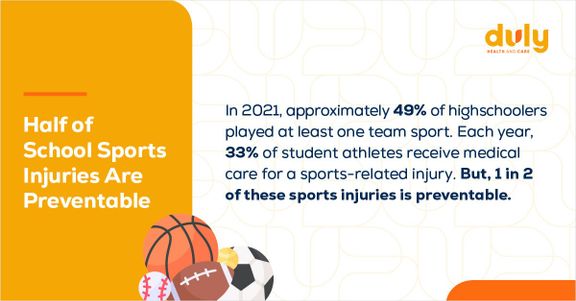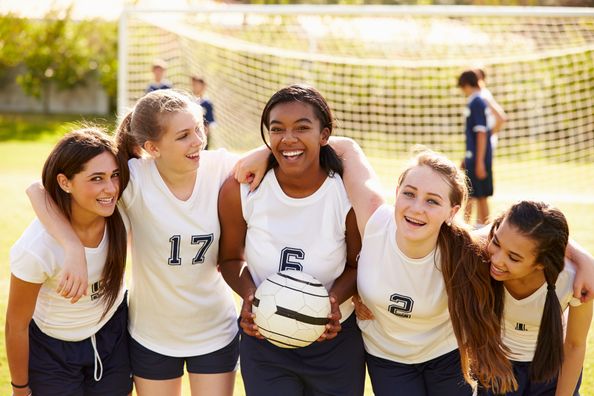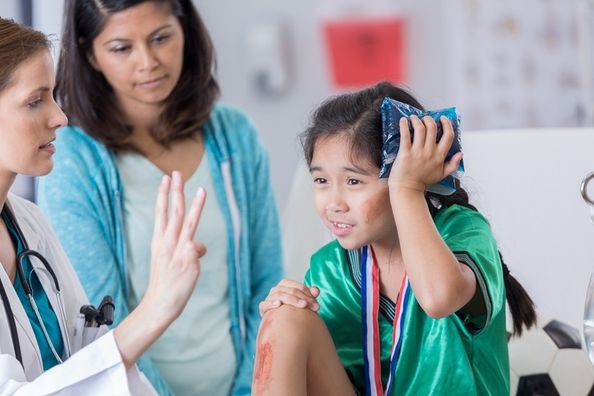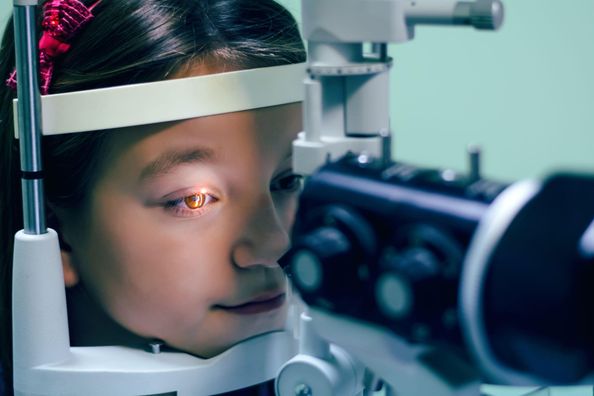It’s the big game day, and both you and your student athlete are excited. Their sports bag is packed, the carpool is planned, and your phone is charged so you can take plenty of photos. They’re ready to play, and you’re ready to cheer them on.
Your athlete is playing their hardest when the worst happens — an injury takes them out of the game.

Source: Centers for Disease Control and Prevention
With fall sports season around the corner, there are steps you and your athlete can take now to prevent a future injury. Sure, many injuries and accidents are unavoidable, but there are things you can do to reduce the risk of injury or reduce the severity of a particular injury.
Here are 3 common injuries fall sport athletes might encounter — and how you can work together to prevent them.
1. Sprains
One of the most common fall sports injuries that your student-athlete might experience is a sprain. Whether your student is a soccer player, cheerleader, or other fall sport athlete, all it takes is a wrong step or tumble to sprain something (usually an ankle or wrist).
A sprain occurs when the tissues that connect your bones at a joint are stretched or torn — usually after a fall or twist. While sprains are one of the more common injuries an athlete might experience during the fall season, there are a couple of steps you can take and help them take to prevent this type of injury:
Promote proper warm-up and stretching: Both coaches and parents alike can encourage young athletes to take the time to do warm-up exercises and dynamic stretches before practice or games. This helps increase flexibility and prepares the muscles for physical activity, reducing the risk of sprains.
Strengthen commonly sprained joints: When you think of a sprain, your mind probably goes right to the ankle. That might be because, in the US, an estimated 2 million ankle sprains happen each year. Your athlete can take steps to prevent an ankle sprain with strengthening exercises like balancing on one leg or doing lunges onto a cushion or foam pad.
Accidents and injuries can happen when you least expect them. Schedule a same-day orthopaedic appointment with Duly Ortho Now at an orthopaedic urgent care clinic near you.
2. Strains
Another common kind of injury your student athlete might encounter is a strain. Similar to a sprain, strains can be stretches or tears. But where sprains typically occur suddenly, a strain can develop over time from overuse.
A typical place for a strain to occur is in the back or legs (like your hamstrings). Strains can be muscles that have stretched too far — but they can also include tearing, too. If your student-athlete has a muscle strain, they may complain of pain, weakness, cramping, or spasms. As a parent or coach, listen to these feelings, as they may tell you that a young athlete should see a sports medicine specialist or physical therapist. You can help them protect their muscles and also reduce their risk of a potential strain.
Encourage a balanced workout: While it may be tempting for young athletes to focus on one sport or one position, overspecialization can lead to the overuse of one specific body part. Your student-athlete should try to do various cross-training activities and workouts that use different muscle groups to avoid too much repetition. A good balance of strength training, flexibility, and cardio can help.
Know when to take it easy: Every kid wants to be the hero of the game, but sometimes their body can’t keep up. It’s important for young athletes to know when it’s time to step up to the plate — and when they may need to rest from a game or practice. Encourage your student-athlete to listen to their body and what it might be telling them.
3. Dislocations
Dislocations are another common injury that can happen on the field (like during a game) or off the field (like while young athletes are hanging out or roughhousing).
Purchase the correct protective equipment: Make sure your athlete has the right gear for the sport they do — and that they wear it A) consistently and B) correctly. This can protect their joints from a hard fall, but it’s also for safety. Depending on the sport, this might include good shoes or cleats, a helmet, a face mask, a mouth guard, or other body pads.
Be wary of future dislocation: Athletes who have already dislocated a joint, like a shoulder or knee, are more likely to dislocate that same joint in the future. If your student-athlete has had a previous injury, talk to their provider about limitations as they recover. Certain motions or exercises may no longer be a good fit — and your athlete should know what they can and can’t do.
At Duly Health And Care — We’re On Your Team
As fall sports season begins, your athlete might be excited to jump right into the swing of practices and games. But overtraining can lead to fatigue and a higher chance of an injury or an accident.
Ease them back into their sport, and give them opportunities to continue to train or cross-train throughout the summer. Encourage them to listen to their body and take breaks when needed. Taking the proper safety precautions can help lower your athlete’s chance of an injury this season. Through the wins and losses, the Duly Sports Medicine Team is here to support them and cheer them on.
Health Topics:








